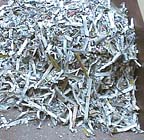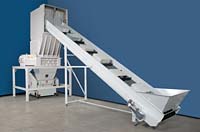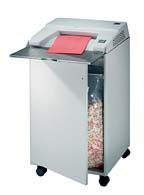Paper Isn’t the Only Thing to shred

For most companies, simply throwing the computers or drives away is not an option. Some choose to erase the drive with either software or degaussing equipment; but experts agree that the process is not always completely effective. The best way to be certain that important information is not accessible after disposal is to physically destroy the hard drive.

handle whole CPUs with no need to take time to remove the hard drives inside. Pictured is what’s left of a CPU.
The process is actually very simple. Drives are placed into a disintegrator and continually shredded until the particles are small enough to pass through a waste disposal screen. The unrecognizable, unreconstructable waste can then be disposed without fear of information theft. This type of one-step destruction is viable and cost-effective for many companies. However, as in all forms of destruction, understanding the process and knowing the requirements is the key to success.
One-step destruction does have its limitations, including those on drive size (1.5 lbs. case weight), volume (drive fed per hour) and collection capacity depending on the method chosen. Maintenance includes periodic blade sharpening, lubrication and replacement of consumable items, all determined by amount of use and volume. None of these items alone or combined are deterrents but must be factored into the cost and overall maintenance budget.
The disintegrator or industrial shredder is a rotary knife mill, which uses a number of rotating and stationary knives working in unison to create a scissor-type cutting action. The level to which the product is cut or broken up is determined by an interchangeable sizing screen. Screens are available with various hole sizes, allowing the end user to tailor the final particle size to specified security requirements. Once the product is destroyed and passed through the sizing screen, it falls into a tote bin or larger collection device (drum, cart, dumpster).
Once hard drive destruction was perfected, the destruction community was faced with another challenge. It seemed the process of opening all the computer cases and removing all the hard drives was becoming a burden to the folks charged with sending in the drives. It may seem like a small thing, but many older tower computers may require as many as 10 screws to be removed before a drive can be taken out; the procedure could take several minutes. In response to demands to simplify the process, machines were developed that will destroy an entire tower or desktop CPU with no need to open the case or remove any items. The dual-shaft design machine literally shreds them into 2-inch wide pieces at random lengths. The 2-inch particle size can be reduced even further, if desired, by running it through a disintegrator.
The decision to purchase a system should not be based on cost, but on potential risk. Even so, many companies simply cannot afford to purchase this equipment for the relatively small number of computers that need to be destroyed. In these cases, destruction services are available.

Side bar: Taming the Paper Tiger
When it comes to sensitive information, most corporations face a mountain of paper problems. And that’s where shredders prove a valuable security tool.
Dahle of Peterborough, N.H., for example, offers a solution with its line of office shredders. These shredders aim at medium size offices and come equipped with a 10 inch feed opening.
With ten models, Dahle office shredders are chain driven to provide slip free power to the cutting cylinders. These cylinders are milled from a solid block of German Solingen Steel. Rubber shock mounts separate the mechanicals from the wooden cabinet and provide whisper quiet operation in order to prevent the disturbance of normal office operations.
For more information, www.dahle.com.
MBM Corp. of North Charleston, S.C., has Destroyit Super Micro-Cut model paper shredders, which produce a shred size of .8 x 4.2 millimeters. This meets the new NSA/CSS specifications and D.O.D. requirements for the destruction of TOP SECRET, COMSEC and SCI paper material. Available in desk side or mobile mid-size models, the units feature solid shaft cutting cylinders, photocells for automatic start/stop and electronic door safety switches.
For more information, www.mbmcorp.com.
Looking for a reprint of this article?
From high-res PDFs to custom plaques, order your copy today!




